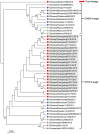Influenza D Virus in Animal Species in Guangdong Province, Southern China
- PMID: 28726609
- PMCID: PMC5547803
- DOI: 10.3201/eid2308.170059
Influenza D Virus in Animal Species in Guangdong Province, Southern China
Abstract
Molecular tests revealed influenza D viruses of D/OK lineage widely circulating in farmed animal species in Guangdong Province, southern China. In particular, we found high levels of influenza D virus infection in goats and pigs. We also detected viral RNA in serum specimens and feces of animals with certain severe diseases.
Keywords: American Landrace pigs; Asian buffalo; China; D/OK lineage; Holstein dairy cattle; hemagglutinin-esterase-fusion gene; hybrid goats; influenza; influenza D virus; viruses; yellow cattle; zoonoses.
Figures


References
-
- Mitra N, Cernicchiaro N, Torres S, Li F, Hause BM. Metagenomic characterization of the virome associated with bovine respiratory disease in feedlot cattle identified novel viruses and suggests an etiologic role for influenza D virus. J Gen Virol. 2016;97:1771–84. 10.1099/jgv.0.000492 - DOI - PMC - PubMed
MeSH terms
Grants and funding
LinkOut - more resources
Full Text Sources
Other Literature Sources

